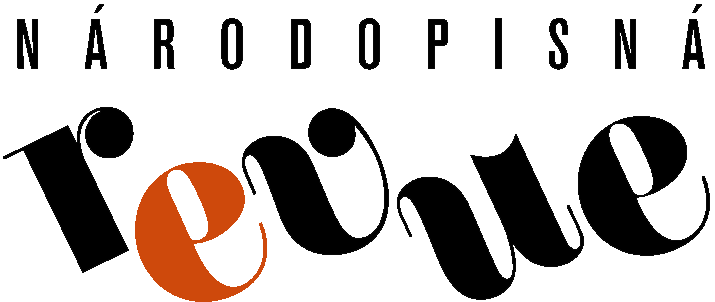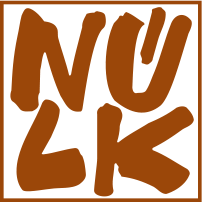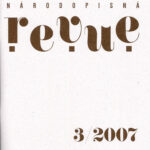Journal of Ethnography 3/2007 pays its attention to Professor Richard Jeřábek (1931 – 2006), an important personality of Czech and European ethnology and the long-year member of Journal of Ethnography ́s editorial board, who died just one year ago suddenly. A lot of his colleagues and students declare their support to his scientific legacy. Some of them have contributed to this issue with their essays and articles that originate from the research themes by Prof. Jeřábek: from historiography and branch theory through ethnographic zoning, ethnicity problems, graphic folk culture up to ethnographic photo and movie.
Karel Altman in his essay reminded of the importance of writers Alois and Vilém Mrštík for ethnographic study of the Moravian country at the turn of the 19th and 20th centuries (Source of knowledge on the life and works of Brothers Mrštík), while Blanka Petráková mentioned the importance and fate of Professor Antonín Václavík (1891 – 1959), founder of the University study of ethnology in Brno (Antonín Václavík and Pozlovice). Helena Beránková dealt with the position of a village photographer (The Local Community and a Photographer – a Photographer and the Local Community / Photographic studio of Antonín Koukal in Uherský Ostroh 1921 – 1956/) and Miroslav Válka wrote about ethnographical zoning (Moravské Horácko, Hřebečsko and Malá Haná – ethnographic regions at the ethical and cultural boundary line). Alena Dunajová (Folk architecture, or folk structural engineering? A contribution the terminological discussion) and Marta Pastierková (Community environment of the village of Blatnica) submitted their expressions on folk architecture. Daniel Drápala (Under the names of Valach and portas – terminological discussion) dealt with the phenomenon of military service in South-Eastern Moravia in the 17th and 18th centuries and Martin Šimša contributed to the theme of Carnival rounds with masks (Carnival Round of „hřebenáři“– new aspects of the relevant interpretation). Alena Kalinová gave an explanation on the history of earthenware research at The Moravian Museum (Comments on Research of the Anabaptist Earthenware at The Moravian Museum before 1945), Eva Večerková introduced the portray of Růžena Šilarová (1913 – 2003), decorated Easter eggs painter from Brandýs nad Labem (Decorated Easter Eggs by Růžena Šilarová) and Hana Dvořáková dealt with the insist author František Diviš (1923 – 2004) from Únanov near Znojmo („Divišov“– the weekday spirit).
In the regular columns, the jubilees of ethnologists Stanislav Brouček (*1947) and Josef Vařeka (*1927) and that of Jan Pavlík (*1937), a personality of folklore movement in the Moravian Slovakia, are mentioned; furthermore, the reports of exhibitions and festivals and the reviews of new book editions are published.
Source of knowledge on the life and works of Brothers Mrštík
Brothers Alois and Vilém Mrštík are two noticeable literature personalities who made their indelible mark in the development of ethnography and folkloristic, inter alia. Their exceptionality consists just in connection of two activity levels, which turned out well on the highest artistic and professional level. With the exclusivity of their literary adaptation of the environment, they could know during their lives, they dominate all other writes who presented the life in the Moravian country. Both of them were excellent experts in folk culture and life of Moravian folk at the turn of the 19th and 20th centuries, especially because of their work at Diváky near Hustopeče where their most important works, including the chronicle Rok na vsi (A Year in the Village) came into being. To evaluate the literary production and the fames of the Mrštíks requires widely conceived endeavour, beginning from the study not only of the corresponding historical resources, but also of the most significant secondary literature. Our contribution calls attention to both.
Antonín Václavík and Pozlovice
Antonín Václavík, the important Moravian ethnographer and founder of the ethnographical department at Brno University, came from the village of Pozlovice, where he was born on 17 July 1891. Childhood and youth spent at Pozlovice near Luhačovice influenced his life way significantly. Along with brother František, they opened the Luhačovice Museum in July 1918. They exhibited their ethnographical collections there, initiating the foundation of the Museum Society in Luhačovice. The research of Václavík ́s native region and the activity of the Museum Society came to a head in issuing the monograph Luhačovické Zálesí in 1930. Václavík made many personal sacrifices to issue the monograph yet he was meeting misunderstanding for plenty of following years. He did not come to hate his native region and he returned often here.
The Local Community and a Photographer – a Photographer and the Local Community (Photographic studio of Antonín Koukal in Uherský Ostroh 1921 – 1956)
Antonín Koukal (1895 – 1972), trained portrait photographer, was operating his studio from the 1920s to the 1950s in Uherský Ostroh. The activity of his photographic studio has some more-generally valid features. In addition to the photographs of the crucial life moments of the inhabitants in the nearest environs (birth, school attendance, recruitment, wedding, death) he dealt with taking the portraits. The contribution is paying its attention to the relations people have to their photos.
Moravské Horácko, Hřebečsko and Malá Haná – ethnographic regions at the ethical and cultural boundary line
The essay deals with the ethnographic division of Western Moravia and adjacent Eastern-Bohemian area. In the Middle Ages, this hilly region was inhabited by local Czech population and German settlers who formed two language islands here: one around the city of Jihlava and the other one between the cities of Moravská Třebová, Svitavy and Lanškroun north of here. In the 18th century’s literature, the region is uniformly called Horácko according to the countryside character, but in the 19th century, the name differentiates based on the language (ethnic) principle. The region settled by German inhabitants in the environs of the cities Moravská Třebová and Svitavy broke away as a specific ethnographic area with the name Schönhengst (Hřebečsko). Ethnographer and museum worker Josef František Svoboda (1874 – 1946) rendered outstanding service to more detailed demarcation of Moravian Horácko based on dialect and phenomena of traditional folk culture. Ethnologist Richard Jeřábek (1931 – 2006) worked up the ethnographic zoning in details.
Folk architecture, or folk structural engineering? A contribution the terminological discussion
The contribution deals with the terms used by ethnology, other branches and amateur public for different meanings. Richard Jeřábek drew attention to that issue as early as in 1974, as he differed the meaning of the terms folk structural engineering and folk architecture whereby the aesthetical criterion became the principal differentiating feature. The author of this contribution holds both terms for synonyms. Within folk architecture or folk structural engineering she considers the determination whether it concerns the professional or non-professional expressions for the determining dichotomy. The survived planning documentation after the mid-19th century substantiates the residential and farm buildings – analogous to the towns- to be designed and later on even built by trained practitioners mostly. In the conclusion of the contribution, other problematic used terms are remembered: village architecture (or structural engineering), rural architecture or vernacular architecture.
Community environment of the village of Blatnica
The contribution is an extract from the PhD thesis that the author wrote under the leadership of Prof. Richard Jeřábek. It is focused on an objective thus critical picture of the community environment at a representatively chosen community in the Slovakian country. Summarizing, the author states that in the course of 20th century not always the real needs of the village society were respected when the community buildings and small solitaires were designed. Sometimes, the final placing of community buildings into the existing community environment of the village was considered in a fully slovenly fashion. It was necessary to think about the complete design of the historical core earlier than in the mid-1980s when many things could not be softened even by planting the full-grown green on the places with the most disturbing visual contacts.
Under the names of Valach and portas – terminological discussion
For nearly two centuries, an armed detachment of “portas” was a part of Moravian history. It was established in 1638 and originally, it was only one of the forms of using the population of Eastern Moravia for military service. At the beginning of its existence, the detachment was called “faithful Wallachians”. This name reflects the period simplified understanding of the word “Valach – Wallachian” as a male inhabitant of mountain regions in Eastern Moravia, who distinguishes himself by certain presumptions for military service. In this understanding, the term “Valach” differs from the former practise according to which this term was used for a farmer breeding sheep and goats on mountain pastures; at that time, it does not refer to the specific ethnographic region in the northeast of Moravia – Moravian Wallachia – yet. Since the end of the 17th century, the term “faithful Wallachians” was substituted by a new term “portas”. The origin of this word can be found in Hungary (frontier guards originally, seigniorial armed men figuratively) from which is has been spread to Silesia and Moravia.
Carnival Round of „hřebenáři“ – new aspects of the relevant interpretation
The Carnival round of „hřebenáři“ and the relating ceremonies have been reflected by professional literature for many times. J. Tomeš dealt with both the older literature sources and the contemporary terrain researches; he subjected both of them to systematic analysis, classification and involvement into the corresponding custom context. R. Jeřábek paid his attention mainly to the European occurrence of the Carnival bear’s masque one of whose versions – as he supposes – just “hřebenář” is. The submitted essay divides the entire apparently unified complex into two different components. The first one is a round of the Carnival bear, regionally called “hřebenář”, connected with prosperity dance. The other one is an almost unknown habit “na hřebeň” whose principle is the married women’s ritual cleaning-up in the form of verbal reproving by masked men taking part in the ritual, whose cleaning-up in watercourse follows. The faith’s importance of both habits comes to the fore especially in the context of religious research that classify both of them as rituals preparing the time renewal on the eve of the new agricultural cycle’s commencement.
Comments on Research of the Anabaptist Earthenware at The Moravian Museum before 1945
The Moravian Museum, owner of an important collection of the Anabaptist faiences, joined the research of the Anabaptists in Moravia as early as before the World War II. At that time, František Pospíšil, head of the ethnographical department, co-operated with Heřman Landsfeld, ceramist, collector, expert on the earthenware production history and pioneer in archaeological research. In the book of records (from the years between 1933 and 1851), we can reveal that the research of the Anabaptists and their earthenware production was an important activity of the ethnographical department, especially between 1942 and 1945 when the Museum participated directly in excavations. A lot of museum documents point to the intention to present the research results at an exhibition. Nevertheless, the most mentioned finds have not been maintained in the collections and it is even not possible to map the research works exactly.
Decorated Easter Eggs by Růžena Šilarová
The author deals with the decorated Easter eggs by Růžena Šilarová (1913 – 2003) from the town of Brandýs nad Labem. She submits the biographical information and analyzes the decoration technique (carving) and ornamental art. Růžena Šilharová ́s works are based on the family tradition as well as on the decoration of embroideries and laces on Central-Bohemian folk costumes. Růžena Šilarová found a free inspiration in them, forming her typical style of decoration. She belonged to the authors who were dealing with the egg decorations for a great part of their lives and found pleasure and use of creative invention and abilities here. Moreover, they were looking for their own approaches.
„Divišov“ – the weekday spirit
The author pays her attention to the colourful installation of storybook world that František Diviš (1923 – 2004) created at the village of Únanov near Znojmo. It is an expression we meet only seldom in our country whereby that is the opinion that such expression is a closed chapter in interpretation by our folk, what prevails. Diviš was a self-taught person, he did not take part in any fine art training and he started with his own works only after he had retired. He made his sculptures of wood, textile, plastic. He finished them with colour, emphasizing the details. His world, called Divišov, must be evaluated as a dynamic unit that cannot be presented in parts. After the author’s death, the installation was reduced.



